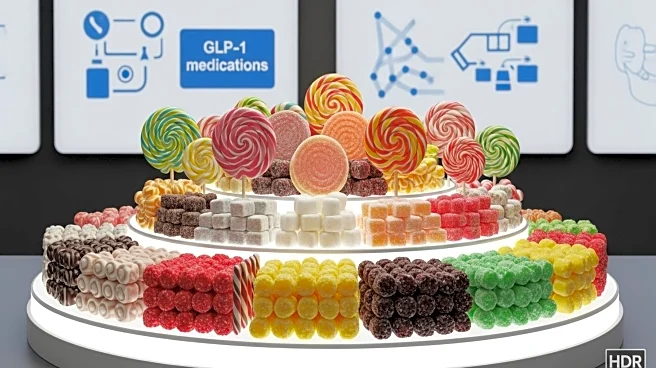What's Happening?
The rise of GLP-1 drugs, originally developed to treat type 2 diabetes, is impacting the confectionery industry. These drugs mimic the hormone GLP-1, which helps users feel fuller for longer, reducing food intake and aiding weight loss. The global market for GLP-1 drugs is valued at $53.46 billion and is expected to grow significantly. As users report healthier eating habits, confectionery manufacturers face challenges, particularly chocolate makers, as cravings decline. Brands like Two Spoons and Sweet Freedom are launching GLP-1-friendly treats, focusing on protein, fiber, and portion control. Chewing gum is also being positioned as an alternative to GLP-1 drug use.
Why It's Important?
The growing popularity of GLP-1 drugs presents both challenges and opportunities for the confectionery industry. As consumer habits shift towards healthier options, manufacturers must innovate to meet new demands. This could lead to a transformation in product offerings, with an emphasis on nutritional profiles and portion sizes. Companies that adapt to these changes stand to benefit, while those that do not may face declining sales. The impact on the industry is significant, as it must navigate the balance between traditional indulgence and health-conscious consumption.
What's Next?
Confectionery manufacturers are likely to continue exploring new product formulations and marketing strategies to appeal to GLP-1 users. As the market for these drugs grows, companies may invest in research and development to create products that align with changing consumer preferences. The industry may also see increased collaboration with health experts to ensure products meet nutritional standards. Long-term, the success of confectionery brands will depend on their ability to innovate and adapt to the evolving landscape.
Beyond the Headlines
The rise of GLP-1 drugs raises ethical questions about the role of pharmaceuticals in shaping consumer behavior and dietary habits. The legal implications for manufacturers include ensuring compliance with health regulations and marketing standards. Culturally, this trend reflects a broader shift towards health-conscious living and the impact of medical advancements on everyday choices. The long-term effects may include a reevaluation of the confectionery industry's role in public health and nutrition.










